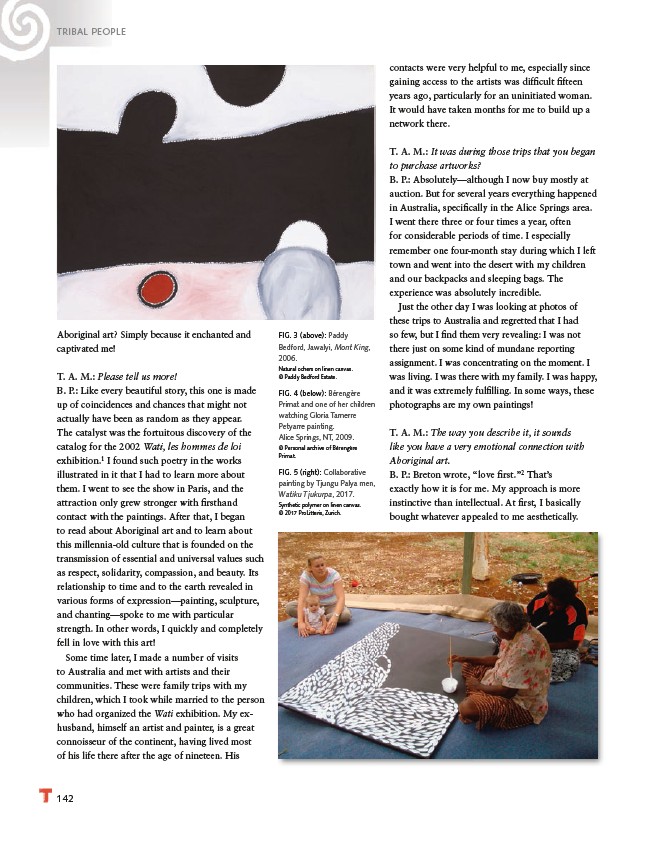
TRIBAL PEOPLE
142
FIG. 3 (above): Paddy
Bedford, Jawalyi, Mont King,
2006.
Natural ochers on linen canvas.
© Paddy Bedford Estate.
FIG. 4 (below): Bérengère
Primat and one of her children
watching Gloria Tamerre
Petyarre painting.
Alice Springs, NT, 2009.
© Personal archive of Bérengère
Primat.
FIG. 5 (right): Collaborative
painting by Tjungu Palya men,
Watiku Tjukurpa, 2017.
Synthetic polymer on linen canvas.
© 2017 ProLitteris, Zurich.
contacts were very helpful to me, especially since
gaining access to the artists was diffi cult fi fteen
years ago, particularly for an uninitiated woman.
It would have taken months for me to build up a
network there.
T. A. M.: It was during those trips that you began
to purchase artworks?
B. P.: Absolutely—although I now buy mostly at
auction. But for several years everything happened
in Australia, specifi cally in the Alice Springs area.
I went there three or four times a year, often
for considerable periods of time. I especially
remember one four-month stay during which I left
town and went into the desert with my children
and our backpacks and sleeping bags. The
experience was absolutely incredible.
Just the other day I was looking at photos of
these trips to Australia and regretted that I had
so few, but I fi nd them very revealing: I was not
there just on some kind of mundane reporting
assignment. I was concentrating on the moment. I
was living. I was there with my family. I was happy,
and it was extremely fulfi lling. In some ways, these
photographs are my own paintings!
T. A. M.: The way you describe it, it sounds
like you have a very emotional connection with
Aboriginal art.
B. P.: Breton wrote, “love fi rst.”2 That’s
exactly how it is for me. My approach is more
instinctive than intellectual. At fi rst, I basically
bought whatever appealed to me aesthetically.
Aboriginal art? Simply because it enchanted and
captivated me!
T. A. M.: Please tell us more!
B. P.: Like every beautiful story, this one is made
up of coincidences and chances that might not
actually have been as random as they appear.
The catalyst was the fortuitous discovery of the
catalog for the 2002 Wati, les hommes de loi
exhibition.1 I found such poetry in the works
illustrated in it that I had to learn more about
them. I went to see the show in Paris, and the
attraction only grew stronger with fi rsthand
contact with the paintings. After that, I began
to read about Aboriginal art and to learn about
this millennia-old culture that is founded on the
transmission of essential and universal values such
as respect, solidarity, compassion, and beauty. Its
relationship to time and to the earth revealed in
various forms of expression—painting, sculpture,
and chanting—spoke to me with particular
strength. In other words, I quickly and completely
fell in love with this art!
Some time later, I made a number of visits
to Australia and met with artists and their
communities. These were family trips with my
children, which I took while married to the person
who had organized the Wati exhibition. My exhusband,
himself an artist and painter, is a great
connoisseur of the continent, having lived most
of his life there after the age of nineteen. His